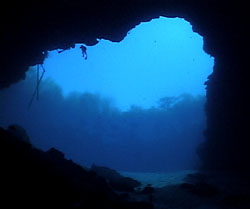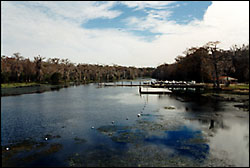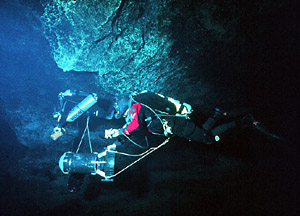Cave Systems:
Chips Hole
The Hydrogeology of the WKP
By Christopher Werner, GUE Hydrogeololgist
INTRODUCTION
The WKP, developed in Leon, Wakulla, and Jefferson Counties, Florida, is characterized by a thin veneer of unconsolidated and undifferentiated Pleistocene quartz sand and shell beds, overlying a thick sequence of relatively horizontal carbonates (Hendry and Sproul, 1966). The WKP is a gently sloping topographic region of low sand dunes and exposed carbonates rising from the Gulf of Mexico to approximately 20 m in elevation within Leon County, the northern terminus being the Cody scarp. The loosely consolidated Pleistocene sands, being very porous and permeable, allow rapid infiltration of precipitation. The St. Marks, Suwannee and Ocala Limestones, underlying the unconsolidated sands, respectively, comprise the Upper Floridan Aquifer System (FAS). These limestones, being very porous, permeable and soluble, have undergone considerable dissolution from groundwater movement (Hendry and Sproul, 1966). As a result, the topography is karstic in nature, with numerous sinkholes, karst windows, sinking streams, and large springs (Rupert, 1988).
 |
|
Cheryl Sink
|
Stratigraphy and lithology of the Woodville Karst Plain (WKP)
The Miocene age sediments include the St. Marks Formation and the Hawthorn Group. The Hawthorn Group is composed of several formations and numerous members. It is primarily a clastic unit, consisting of fine to medium grained sandy clays and silty, clayey sands, with variable amounts of carbonate (Rupert, 1988). These are usually interbedded and sometimes contain minor amounts of dolomite and phosphate. Much of the Hawthorn has limited permeability and acts as a confining unit north of the Cody scarp, called the Tallahassee Hills.
The St. Marks sediments are predominately fine to medium fine grained, partially recrystallized, silty to sandy limestones that have undergone degrees of secondary dolomitization (Hendry and Sproul, 1966). Within the WKP, the St. Marks Formation comprises the top of the Upper FAS (Rupert, 1988). It also contains extensive shallow conduits in portions of the Leon Sinks cave system and Indian Springs cave. It pinches out against the Suwannee Limestone in southwestern Jefferson County and reaches a maximum thickness of approximately 60 m toward western Wakulla County.
 |
|
Sullivan Sink
|
The Suwannee Limestone of the Oligocene reaches a maximum thickness of 160 m at approximately 30 m to 150 m below the land surface within Leon and Wakulla Counties (Davis, 1996). The thickest portion of the Suwannee is found south of Tallahassee at the Gulf of Mexico and the thinnest located near the Georgia border (Hendry and Sproul, 1966). It consists of two types of permeable rock; (1) a crystalline tan, highly fossiliferous limestone and (2) a white to cream, finely crystalline limestone containing foraminifera with micritic limestone pellets (Davis, 1996). The Suwannee limestone is the principal lithology transporting much of the groundwater of the Upper FAS within the WKP. The majority of dissolution conduits within the WKP are primarily developed in the Suwannee limestone.
Structural setting of the WKP
The regional structure of the area surrounding the WKP has four major components: (1) the Apalachicola Embayment, (2) the Gulf Trough in southwestern Georgia, (3) the Peninsular Arch, and (4) the Ocala Uplift. These four features have provided the necessary conditions precluding the initiation of karst conduit development in the WKP.
The Apalachicola Embayment, sometimes referred to as the Southwest Georgia Embayment, and located west of the WKP, is a southwest-plunging syncline containing a thick sequence of predominantly clastic material (Miller, 1986). It is thought that this feature is the middle Mesozoic to middle Cenozoic depositional basin of the Apalachicola River (Schmidt, 1984). In some instances, carbonate deposition spilled westward from the Florida platform into the embayment. The region has continued to subside and the downwarping of sediments are observed, as well as the thickening of Ocala, Suwannee, and St. Marks limestones to the west from the WKP.
The Gulf Trough is a series of northeast-trending faults that bound a series of small grabens (Miller, 1986). These grabens are primarily low permeability clastic rocks which have been down-dropped on either side opposite the thick sequence of carbonates. These fault bounded, down-dropped blocks have the effect of retarding the flow of groundwater from the north within the FAS (Miller, 1986).
The Peninsular Arch is a northwest-trending feature that was continually positive from Jurassic until Late Cretaceous time (Miller, 1986). It may have also been sporadically positive during the Cenozoic also. The effect of this feature has been to control sedimentation in north-central Florida and has been proposed to be a result of compressional tectonics (Miller, 1986).
The Ocala Uplift is another northwest-trending uplift paralleling the Peninsular Arch to the west. The Ocala Uplift only effects sediments of middle Eocene and younger, and is thought to be a buildup of Eocene carbonate sediments, or more likely, a compaction of Eocene material after deposition (Miller, 1986).
The regional structural features of the Apalachicola Embayment and the Peninsular Arch bounding the WKP have been influential in its history by setting the stage for deposition of carbonates following in time. The Eocene compaction of sediments from the Ocala uplift and the fault bounded down-dropped blocks of the Gulf Trough have been the regional structural controls responsible for creating the current exposure of Miocene and Oligocene carbonates seen at the surface . These structural manifestations have allowed the overlying sediments of the Hawthorn Group within the WKP to be subjected to physical and chemical erosion from the Gulf shoreline during the Quaternary. These influences have culminated in the proper geologic setting conducive to karst conduit formation.
Regional hydrology encompassing the WKP
The regional aquifer system is divided into two distinct water bearing units, the surficial aquifer and the FAS. In most places surrounding the WKP, low permeability rocks of the upper confining unit of the Floridan, separate the surficial and FAS. The upper confining unit is comprised of consistently low permeability clastic rocks. The surficial aquifer is usually comprised of poorly consolidated to unconsolidated clastic rocks and sediments where water typically occurs in unconfined conditions (Miller, 1986). The upper confining unit is absent within the WKP. The Upper FAS includes Tertiary carbonates formed during the Oligocene and Miocene Series and is overlain by deposits from the Pliocene, Pleistocene and Holocene (Hendry and Sproul, 1966). Specifically within the WKP, the Upper FAS is comprised of the St. Marks, Suwannee, and Ocala limestones.
 |
|
Wakulla Springs Cavern Zone
|
The regional recharge area for WKP extends north of the Georgia border for over 80 km and covers portions of over five Georgia Counties (Davis, 1996). The regional groundwater flow pattern, taken from piezometric contour maps, shows overall south trending flow lines (Davis, 1996). There is an interesting feature of the piezometric contour maps which show a saddle or potentiometric low area extending well into the WKP. This causes a convergent flow line pattern toward the southern-central area of the karst plain. In this area, there are several major first-order magnitude springs including Wakulla Springs, the St. Marks Spring Group, Spring Creek Spring, and Wacissa Springs. This regional convergence of flow is thought to originate from the fact that the WKP confining unit is absent. Thus flow through Leon county, being confined by the Miccosukee and Hawthorn Formations, converges in the WKP, where the lack of these confining units allows groundwater mass transport to result in artesian flow at the surface.
 |
|
Wakulla River, from the head spring
|
Most groundwater circulation is thought to take place within the Upper FAS (Miller, 1986). The groundwater within the Upper FAS is also less mineralized than that of the Lower FAS (Sprinkle, 1985), and hence is regarded as such because of vigorous circulation. This circulation is believed to be the result of high moldic and intergranular porosity, as well as secondary dissolution (Miller, 1986). This however, does not indicate that there is not deep circulation or mixing of groundwater from the Lower FAS. In places, there may be a mechanism for transporting older deeper water up into the Upper FAS by means of a reduced pressure head.
Local hydrology of the WKP
There are several extensive underwater caves systems developed within the WKP due to dissolution, which is evident through the related karst topography. These cave systems extend over several kilometers and are limited by depths not exceeding 100 m. There exists several distinct levels of conduit development at various depths below mean sea level. These passage levels may have been formed due to preferential groundwater flow at certain levels.
As stated earlier, the loosely consolidated sands, being very porous and permeable, allow rapid infiltration of precipitation. Likewise there are a few surface stream which dive below land surface upon entering the WKP. Some streams are intermittent, with the ability to transport water only when the infiltration rate is exceeded and surface runoff is initiated through excessive precipitation with respect to volume and/or time. In some places within the Leon Sinks Geological Site, groundwater emerges and flows in a surface stream and then, within a few tens of meters, sinks below ground once again.
The Upper FAS has very high transmissivity rates, due to the high permeability and porosity of these limestones, and is the principal member in local groundwater flow. Much of the drainage is subsurface, within the WKP, through large open conduits, developed in the St. Marks and Suwannee Limestones. Cave divers of the Woodville Karst Plain Project (WKPP), have conducted surveys of many of the underwater conduits establishing the existence of a large network of interconnecting passages. Over 33.5 km of surveyed passage has been mapped to date. Approximately 22.8 km of passage have been connected to establish the Leon Sinks Cave System (Irving, 1996), the largest and deepest underwater cave system within the United States.
WKP conduit system descriptions
Maps and surveys were obtained from Irving (1996), and a detailed preliminary analysis was conducted of the Leon Sinks cave system, as well as Indian Spring, Sally Ward Spring, Chips Hole, Shepard Spring and Wakulla Springs cave systems. It was apparent very early from the maps, that the caves of the WKP exhibited multiple drainage lines and these passages appeared to be tiered. The passage lengths were calculated and totaled at certain mean depths below sea level. These corresponding depths were grouped at approximately three meter intervals.
 |
|
Wakulla Springs
|
It was readily apparent these conduits could be grouped into several distinct levels. The levels were named A through E and given an appropriate range of approximate depths. The passage levels shown to exhibit the most prominent development within the WKP were as follows:
| Level | Passage level depth in meters below mean sea level | Percent of total passage length |
| A | -12.0 to -18.0 | 9.2 |
| B | ~ -24.0 | 6.8 |
| C | -30.0 to -36.0 | 10.1 |
| D | -52.0 to -64.0 | 31.7 |
| E | -79.0 to -85.0 | 31.9 |
It is important to notice that levels A through C could be group as a single level but were not because of the differing cave systems in which they are located and the level itself would be within a range of over 25 m. There does appear to be some local variations in the shallow levels, which would constituent separating these into three distinct levels, involving localized drainage basins within the WKP.
 |
|
WKP Conduit
|
The morphology of the cave systems within the WKP suggest a tiered, multiple line drainage pattern which has been documented in the Mammoth-Flint Ridge cave system of Kentucky (Palmer, 1981). The effect of base level fluctuations are obviously more complex than a simple downcutting fluvial system. With further investigation, it should be possible to ascertain the paleodrainage of the WKP cave systems. The degree of structural and lithologic control on a local level must also be ascertained to provide a complete overview of the hydrogeologic regime within the WKP.
References
- Davis, H.,
- 1996, Hydrogeologic Investigation and Simulation of Ground-Water Flow in the Upper Floridan Aquifer of North-Central Florida and Delineation of Contributing Areas for Selected City of Tallahassee, Florida, Water Supply Wells: USGS Water-Resources Investigation Report 95-4296.
- Hendry, C. W., and Sproul, C. R.,
- 1966, Geology and groundwater resources of Leon County, Florida: Florida Geologic Survey Bulletin 47.
- Irving, Steve,
- 1996, Woodville Karst Plain Project, personal communication.
- Miller, James A.,
- 1986, hydrologic framework of the Floridan aquifer system in Florida and in parts of Georgia, Alabama and South Carolina: U. S. Geologic Survey Professional Paper 1403-B.
- Palmer, A. N.,
- 1981, A geological guide to Mammoth Cave National Park, Zephyrus Press, Teaneck, NJ.
- Rupert, Frank,
- 1988, Geology of Wakulla County, Florida: Florida Geologic Survey Bulletin 60.
- Schmidt, W.,
- 1984, Neogene stratigraphy and geologic history of the Apalachicola Embayment, Florida: Florida Geological Survey Bulletin 58.
- Sprinkle, C. L.,
- 1985, Geochemistry of the Floridan aquifer system in Florida and in parts of Georgia, South Carolina, and Alabama: U. S. Geologic Survey Professional Paper 1403-I.
